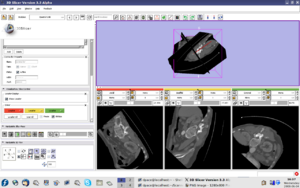Difference between revisions of "IGT:ToolKit/Navigation-with-Aurora"
From NAMIC Wiki
| Line 18: | Line 18: | ||
==Tutorial Materials== | ==Tutorial Materials== | ||
| − | * Tutorial slides for the Advanced Navigation Tutorial | + | * [[Media:IGTAdvancedNavigation.pdf|Tutorial slides]] for the Advanced Navigation Tutorial |
* Atlas: download the .zip file from either the [http://www.na-mic.org/pages/Special:PubDB_View?dspaceid=1265 SPL-PNL Brain Atlas] or the [http://www.spl.harvard.edu/pages/Special:PubDB_View?dspaceid=1266 SPL Abdominal Atlas] | * Atlas: download the .zip file from either the [http://www.na-mic.org/pages/Special:PubDB_View?dspaceid=1265 SPL-PNL Brain Atlas] or the [http://www.spl.harvard.edu/pages/Special:PubDB_View?dspaceid=1266 SPL Abdominal Atlas] | ||
| Line 55: | Line 55: | ||
* [http://www.spl.harvard.edu/pages/People/noby Nobuhiko Hata] | * [http://www.spl.harvard.edu/pages/People/noby Nobuhiko Hata] | ||
* [http://www.spl.harvard.edu/pages/People/dpace Danielle Pace] | * [http://www.spl.harvard.edu/pages/People/dpace Danielle Pace] | ||
| − | |||
| − | |||
| − | |||
| − | |||
| − | |||
| − | |||
| − | |||
| − | |||
| − | |||
| − | |||
| − | |||
| − | |||
| − | |||
| − | |||
| − | |||
| − | |||
| − | |||
| − | |||
| − | |||
| − | |||
| − | |||
| − | |||
| − | |||
| − | |||
| − | |||
| − | |||
| − | |||
| − | |||
| − | |||
| − | |||
| − | |||
| − | |||
| − | |||
| − | |||
| − | |||
| − | |||
Revision as of 16:55, 5 June 2008
Home < IGT:ToolKit < Navigation-with-AuroraBack to IGT:ToolKit
Contents
Overview:
This tutorial uses an NDI Aurora tracking system to explain how navigation works in Slicer3. It also contains a more advanced description of the OpenIGTLink protocol.
The general IGT navigation system consists of the following components:
- Slicer3 - the base platform
- OpenIGTLink module - a loadable software module plugged into Slicer3
- IGSTK - an interfacing tool for common commercial tracking devices
- A tracking device - such as the NDI Aurora magnetic tracking system
Before you start the advanced tutorial, you should go through the Basic Navigation Tutorial.
Tutorial Materials
- Tutorial slides for the Advanced Navigation Tutorial
- Atlas: download the .zip file from either the SPL-PNL Brain Atlas or the SPL Abdominal Atlas
Required Hardware
- NDI Aurora tracking device with tracked tool
- If your computer does not have a serial port, you will need a Serial-to-USB converter
Software Installation Instructions
Step 1: Install Slicer3
Go to the Slicer3 Install site.
Step 2: Install the OpenIGTLink module
OpenIGTLink is a communication protocol used to interface Slicer3 with external devices, such as trackers, imaging devices and robots. OpenIGTLink is currently distributed as a loadable module for Slicer3.
- Step 2a: You have the choice of either downloading a precompiled version (binary) OR building it yourself from the source code:
- Precompiled OpenIGTLink module (for use with Slicer 3.2): Download and unzip.
- Building the OpenIGTLink module from source code: Find the instructions here
- Step 2b: Copy the binary into your-slicer3-build(install)-directory/lib/Slicer3/Modules. You should see the OpenIGTLink module in the Slicer3 module list once Slicer3 is started.
Step 3: Install IGSTK and IGSTKSandbox
IGSTK is used to acquire tracking data from the NDI Aurora tracking system.
- You have the choice of either downloading a precompiled version (binary) OR building it yourself from the source code:
- Precompiled IGSTK: Download and unzip - you should find the directory IGSTKSandbox-build
- For Windows (32-bit).
- For Mac OS X (x86).
- For Linux (x86, 32-bit).
- For Linux (x86, 64-bit).
- Building IGSTK and IGSTKSandbox from source code: Find the instructions here
- Precompiled IGSTK: Download and unzip - you should find the directory IGSTKSandbox-build
